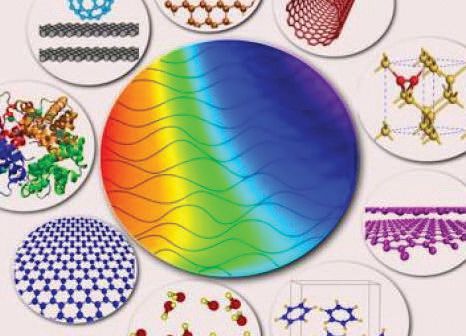New characterization of van der Waals interactions
Dr. Neil Canter, Contributing Editor | TLT Tech Beat June 2016
This finding helps to explain why vdW interactions occur over significantly longer distances at the nanoscale.
KEY CONCEPTS
•
Past perceptions that van der Waals forces are weak have changed. They can substantially influence the magnitude of friction at the nanoscale.
•
A new study reveals that van der Waals forces at the nanoscale occur through interactions between wave-like charge density fluctuations.
•
These van der Waals interactions were found between one-dimensional carbyne-like atomic wires and two-dimensional systems such as molybdenum disulfide.
IN CHEMISTRY, VAN DER WAALS (vDW) OR DISPERSION INTERACTIONS are considered weak, non-bonded (or non-covalent) forces that lead atoms or molecules to attract one another. However, the significance of these vdW forces has grown, particularly as instrumentation for studying the interactions between objects at the nanoscale has improved. Ongoing work shows that vdW interactions can have a substantial influence on the magnitude of friction detected at the nanoscale.
vdW interactions are ubiquitous in nature and have an effect on the structure, stability and function of systems found throughout chemistry, biology, physics and material science (
see Figure 3).
 Figure 3. A new study finds that van der Waals forces between nanostructures occur through wavelike charge density fluctuations and show strength over a distance that is relevant to the design and control of the assembly of complex nanostructures. (Figure courtesy of Cornell University.)
Figure 3. A new study finds that van der Waals forces between nanostructures occur through wavelike charge density fluctuations and show strength over a distance that is relevant to the design and control of the assembly of complex nanostructures. (Figure courtesy of Cornell University.)
An example of the growing influence of vdW interactions originates from a recent TLT article (
1) discussing the development of solid lubricant heterostructures. The objective of the researchers was to combine two different solid lubricants in order to minimize the negative characteristics seen with each solid lubricant. In this work, a heterostructure based on tungsten disulfide and graphene was prepared.
The individual arrangements of the graphene and tungsten disulfide atoms were not changed. The researchers believe that vdW forces hold the heterostructure together because there are no charged interactions between the graphene and tungsten disulfide molecules.
Robert A. DiStasio Jr., assistant professor of chemistry and chemical biology at Cornell University in Ithaca, N.Y., says, “There are essentially two schools of thoughts regarding the nature and origin of vdW interactions. The first one can be best described by considering the interaction between two isolated noble gas atoms such as neon or argon. No dipole or charged interactions exist between the two atoms. However, the spherical electron clouds found around each atom will fluctuate over time and change shape. In doing so, fleeting dipole moments will be induced on each atom due to the uneven distribution of negative and positive charges. vdW interactions, which are the electrodynamic coupling of these induced dipole moments, enable the two atoms to become attracted to each other.”
The second school of thought originates from the physics perspective and characterizes vdW interactions by the Casimir Effect. DiStasio says, “Imagine that there are two macroscopic surfaces placed in a vacuum. Fluctuations in the vacuum lead to the propagation of wavelike perturbations that are analogous to an individual dropping a pebble in a pond. The interaction of these waves is the origin of the vdW forces that cause the two surfaces to either attract or repel each other.”
The problem with both schools of thoughts is that vdW interactions that were once thought to be very localized near specific atoms or surfaces have been found to occur over significantly longer distances amounting to tens of nanometers. This has been verified by recent experimental data.
DiStasio says, “Originally, the double helix structure of DNA was thought to be exclusively held together by hydrogen bonding. However, recent work shows that stacked nucleobases in DNA chains interact with each other over long distances by vdW forces.”
A new approach is therefore needed to better understand the nature of vdW interactions at the nanoscale that can link the particle-like theory supported by chemists and the wave-like theory supported by physicists. Such an approach has now been developed.
WAVELIKE CHARGE DENSITY FLUCTUATIONS
In a joint collaboration, DiStasio and professor Alexandre Tkatchenko of the University of Luxembourg and the Fritz Haber Institute of the Max Planck Society have proposed a new way to describe vdW interactions at the nanoscale. He says, “We found that a physically sound and accurate description of the vdW forces between nanostructures must account for the interactions between wave-like charge density fluctuations. By carrying out simulations on one- and two-dimensional systems consisting of carbyne wires, hydrocarbon polymers and inorganic compounds, we found a significant enhancement in the strength of vdW force over the range of 10 to 20 nanometers—a length scale that is most relevant to the design and control of the assembly of complex nanostructures.”
The first system studied in this work is a linear one-dimensional carbyne-like atomic wire that consists of 2,000 carbon atoms. The researchers also varied the distance between the carbon atoms in this wire from 1.2 to 2 angstroms. The former is the distance between carbon atoms in the simplest carbyne, acetylene.
Tkatchenko says, “Through compression and expansion of these carbyne wires, we found that the electron density fluctuations are more like polarizable waves. These waves result from head-to-tail dipole fluctuations across the entirety of each wire. When two carbyne wires are placed in close proximity to each other, it is the interaction of these extended polarizable waves that leads to such a strong vdW interaction.”
Two-dimensional systems studied included graphene, a hydrocarbon polymer and the inorganic compound, molybdenum disulfide. DiStasio says, “We know that vdW forces play a role in how two molybdenum disulfide layers rub against each other.” The researchers found that the vdW forces in these two-dimensional systems can also be quite enhanced and better explained through the interactions of wave-like charge density fluctuations.
Future research will involve doing more theoretical work, particularly in modifying the current model to treat metals where delocalized electrons are already known to produce wave-like interactions. DiStasio says, “Our hope is that this work in characterizing vdW interactions will enable researchers to design new molecules where the frictional effects at the nanoscale can be made either stronger or weaker depending upon the specific application.”
DiStasio is also very interested in seeing how vdW interactions can be characterized in the phospholipids aggregates and bilayers widely found in biological systems. He says, “I am certain that vdW forces will influence the fluidity of biological membranes which is clearly another form of friction.”
Additional information can be found in a recent article (
2) or by contacting DiStasio (
distasio@cornell.edu) and Tkatchenko (
alexandre.tkatchenko@uni.lu) directly.
REFERENCES
1.
Canter, N. (2015), “Potential of van der Walls heterostructures as solid lubricants,”
Tribology and Lubrication Technology,
71 (2), pp 10 – 11.
2.
Ambrosetti, A., Ferri, N., DiStasio, R. and Tkatchenko. A. (2016), “Wavelike charge density fluctuations and van der Waals interactions at the nanoscale,”
Science,
351 (6278), pp 1171 – 1176.
 Neil Canter heads his own consulting company, Chemical Solutions, in Willow Grove, Pa. Ideas for Tech Beat can be submitted to him at neilcanter@comcast.net
Neil Canter heads his own consulting company, Chemical Solutions, in Willow Grove, Pa. Ideas for Tech Beat can be submitted to him at neilcanter@comcast.net.